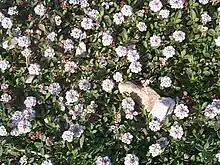Hernandulcin
Hernandulcin is an intensely sweet chemical compound gained from the chiefly Mexican and South American plant Lippia dulcis.[1]
 | |
| Names | |
|---|---|
| Preferred IUPAC name
(6S)-6-[(2S)-2-Hydroxy-6-methylhept-5-en-2-yl]-3-methylcyclohex-2-en-1-one | |
| Identifiers | |
3D model (JSmol) |
|
| ChemSpider | |
PubChem CID |
|
| UNII | |
CompTox Dashboard (EPA) |
|
| |
| |
| Properties | |
| C15H24O2 | |
| Molar mass | 236.35 g/mol |
Except where otherwise noted, data are given for materials in their standard state (at 25 °C [77 °F], 100 kPa).
Infobox references | |

History and origin
In the 1570s, Spanish physician Francisco Hernández[2] described a remarkably sweet plant known to the Aztecs as Tzonpelic xihuitl, meaning "sweet herb". This reference, accompanied by an accurate description and illustration of the plant, led to a group of pharmacognocists in 1985 to a previously unrecognised, intensely sweet chemical that can provide sweetness without tooth decay. Cesar M. Compadre, and A. Douglas Kinghorn, from the University of Illinois at Chicago isolated and identified the sweet compound from the leaves and flowers of the Lippia dulcis plant, in Mexico. The researchers noted the chemical structure of the colourless oil, and named it hernandulcin after Francisco Hernandez.
Structure
Hernandulcin is a sesquiterpene with the molecular formula C15H24O2. By slightly modifying the compound, researchers have identified the three parts of the chemical structure that produced the intense sweet taste - the carbonyl group, the hydroxyl group, and the hydrophobic side chain. Hernandulcin was the first sesquiterpene found to be sweet, and after a panel of volunteers tasted hernandulcin, it was determined that it was more than 1,000 times sweeter than sugar. Hernandulcin also has a minty aftertaste, and does not cause tooth decay, which would make it a good candidate for oral hygiene products.
References
- "Dansukker Sweetness Glossary". Archived from the original on September 28, 2007. Retrieved August 19, 2007.
- "Find Articles Science News (from 1985)". Science News. 1985. Retrieved August 19, 2007.
External links
 Media related to Hernandulcin at Wikimedia Commons
Media related to Hernandulcin at Wikimedia Commons